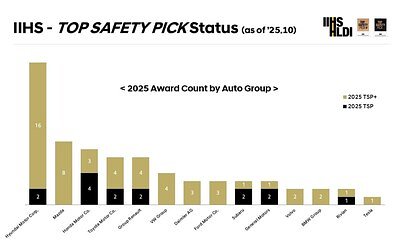
Hyundai Leads the Pack as IIHS Raises the Bar for Vehicle Safety in 2025
Hyundai, Kia, and Genesis models dominate the latest IIHS safety ratings, showcasing a commitment to innovation as the institute implements tougher testing standards for 2025. Is this a new era for automotive safety?
Hyundai Leads the Pack as IIHS Raises the Bar for Vehicle Safety in 2025
Seoul, South Korea – November 5, 2025 – Hyundai Motor Group is solidifying its position as a global safety leader, with the 2026 Hyundai IONIQ 9, 2026 Kia Sportage, and 2026 Hyundai Santa Cruz earning top marks in the latest Insurance Institute for Highway Safety (IIHS) evaluations. The accolades come as the IIHS implements significantly stricter testing protocols for 2025, demanding a higher level of crashworthiness and advanced safety technology. With a total of 18 models earning either the TOP SAFETY PICK+ (TSP+) or TOP SAFETY PICK (TSP) rating this year, Hyundai is demonstrably rising to the challenge – and setting a new benchmark for the industry.
A Tougher Test, A Stronger Response
The IIHS’s revamped criteria aren’t merely incremental adjustments; they represent a fundamental shift in vehicle safety evaluation. This year’s tests place a greater emphasis on rear passenger protection, with enhanced side-impact assessments and rigorous evaluations of structural integrity. “The IIHS is pushing the boundaries of what we expect from vehicle safety,” explains one industry analyst. “These updated tests demand more than just airbags and seatbelts; they require a holistic approach to vehicle design and engineering.”
The 2026 IONIQ 9 and Sportage earned the coveted TSP+ rating, signifying exceptional performance across all crash tests, as well as advanced ratings for headlight performance and the effectiveness of their standard-equipped front crash prevention systems. The Santa Cruz, a popular compact pickup, secured the TSP rating, demonstrating a strong commitment to safety in a segment where it’s often an afterthought.
Hyundai's Winning Formula
Hyundai’s consistent success isn’t accidental. The company has made a deliberate and sustained investment in safety innovation, integrating advanced technologies and prioritizing structural enhancements. “We’ve focused on building vehicles that not only meet but exceed safety standards,” stated a company spokesperson. “This isn’t just about achieving a good rating; it’s about protecting our customers and their families.”
Key to Hyundai’s success is its implementation of advanced airbag systems, designed to provide better protection for rear-seat passengers. The company has also significantly improved the structural integrity of its vehicles, employing high-strength materials and optimized frame designs to withstand higher impact forces. Furthermore, Hyundai’s commitment to advanced driver-assistance systems (ADAS) – including automatic emergency braking, lane-keeping assist, and blind-spot monitoring – has played a crucial role in earning top marks from the IIHS.
Beyond the Ratings: Real-World Impact
The benefits of these advancements extend far beyond achieving a good rating. High safety ratings have a tangible impact on driver and passenger well-being, reducing the risk of injury or fatality in the event of a crash. “Consumers are increasingly prioritizing safety when making vehicle purchasing decisions,” notes a consumer reports analyst. “A vehicle with a TSP+ or TSP rating provides peace of mind, knowing that you and your loved ones are protected by the latest safety technology.”
Beyond the immediate benefits to drivers and passengers, high safety ratings also have a positive economic impact. Vehicles with top safety ratings experience an average resale value increase of 5-7%, making them a smart long-term investment. Furthermore, insurance companies often offer discounts to owners of vehicles with advanced safety features, reducing the overall cost of ownership.
Competition Heats Up
While Hyundai currently leads the pack, competition is intensifying. Toyota earned 12 TSP/TSP+ awards, followed by Honda with 9 and Ford with 7. These automakers are also making significant investments in safety technology, and the gap is likely to narrow in the coming years. “The IIHS’s updated standards are forcing automakers to raise their game,” explains an automotive industry analyst. “This is a win for consumers, as it will drive innovation and ultimately make our roads safer.”
Production Dates and Early Models
It’s worth noting that to qualify for the 2025 IIHS ratings, vehicles must be built to the latest specifications. Approximately 60% of early production units of the IONIQ 9 and Sportage, and 50% of the Santa Cruz, meet these criteria. This means that some early models may not have all the latest safety features. Consumers should verify that the vehicle they are considering meets the latest standards before making a purchase.
The Future of Automotive Safety
Hyundai’s success in the latest IIHS evaluations underscores the company’s commitment to safety and innovation. As the automotive industry continues to evolve, with the advent of autonomous driving and electric vehicles, safety will remain a top priority. The IIHS’s updated standards are a crucial step in ensuring that these new technologies are safe and reliable. The competition among automakers will undoubtedly continue to drive innovation, ultimately benefiting consumers and making our roads safer for everyone. The new standards aren't just about protecting occupants in a crash; they’re about preventing crashes from happening in the first place, paving the way for a future where zero traffic fatalities are not just a dream, but a reality.
